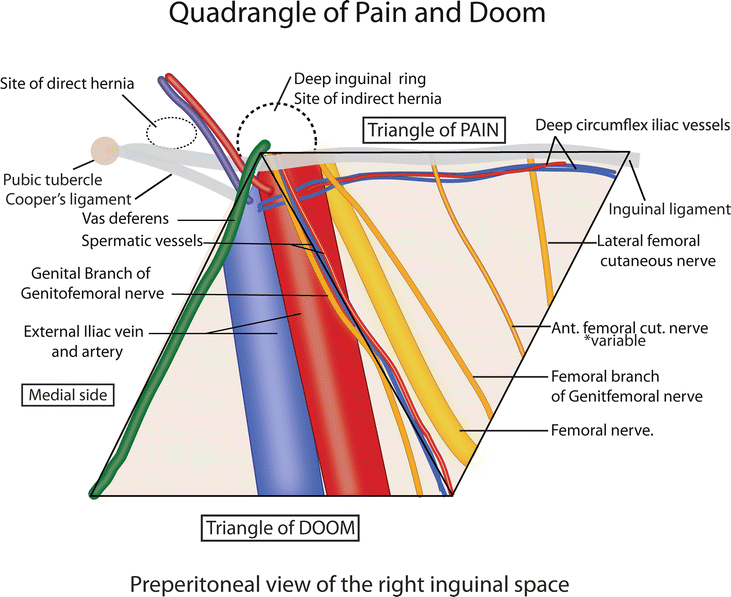Groin hernias
- MDs don't LIe (Direct hernias are Medial to inferior epigastric; Indirect hernias are Lateral)
- Incarceration = cannot reduce hernia contents
- Strangulation = incarcerated hernia with reduced blood flow -> ischemia/necrosis
| Population | Etiology | Location | ||
| Inguinal (96%) |
Indirect (>50%) | M:F 8:1 |
2/2 patent processus vaginalis (congenital) females have smaller internal ring (testicle did not need to pass through) -> lower incidence of indirect hernia in women |
lateral to inferior epigastric; goes through internal ring/inguinal canal/external ring/into scrotum |
| Direct | 2/2 mechanical breakdown - weakness in floor of inguinal canal | medial to inferior epigastric; within Hesselbach's triangle (goes through abdominal wall) | ||
| Femoral (<5%) |
F >> M |
weak/widened femoral ring with aging, injury 40% present as emergency (incarceration or strangulation) |
inferior to inguinal ligament; goes through femoral ring (medial to femoral vein, lateral to lacunar ligament) | |

History
- Risk factors: hx hernia, older age, male, chronic abdominal pressure (cough, constipation), abdominal wall injury
- ? inciting event - heavy lifting, etc.
- Duration, any prior hernias/hernia repairs
- Sx - groin bulge/discomfort (may not be visible), worse with Valsalva/increased intra-abdominal pressure (heavy lifting, standing)
- Pain, reducible, episodes of incarceration (+/- pain, +/- bowel obstruction, cannot reduce hernia)/strangulation (bowel ischemia - skin changes, peritonitis)
Physical
- Groin bulge usually more easily visualized with standing/Valsalva
- Palpating bulge/hernia will note 'impulse' when patient coughs
- In men, use index finger to invaginate scrotal skin into the external ring/inguinal canal to palpate hernia
- Difficult to examine in women; may need ultrasound
- Usually clinical diagnosis is sufficient
- May use ultrasound to confirm diagnosis if needed, or to differentiate from hydrocele/varicocele etc.
Indications for surgical repair
- Goal of repair is to avoid incarceration, strangulation, bowel necrosis, SBO, pain
- Uncomplicated inguinal hernia with mod/severe sx - elective repair
- Asx/minimal sx can have elective surgery if patient desires, or just do watchful waiting
- Nonsurgical management - hernia belt/truss
- Complicated inguinal hernia
- Strangulation/bowel obstruction - urgently, to prevent bowel necrosis
- Incarceration - surgery vs. attempt at reduction with elective repair within a few days
- Femoral hernias - early elective repair (high risk of strangulation)
Indications for laparoscopic repair
- bilat inguinal hernias (can do both sides through one set of incisions)
- recurring hernia with prior open repair (use new tissue plane, and vice versa)
- need to resume full activity ASAP
Other notes
- Do not place mesh if risk of infection
- Open repair can be done with local anesthesia/MAC if patient cannot tolerate general anesthesia
Repair techniques
- Op note
- Non-mesh
- Bassini - suture shelving edge of inguinal ligament to conjoined tendon (internal oblique, transversus abdominus, transversalis fascia)
- McVay - like Bassini but suture more medially to abdominus aponeurosis (tension free)
- Shouldice - imbricate floor of inguinal canal
- Mesh
- Lichtenstein - tension free with mesh
- Laparoscopic
- TAPP = transabdominal preperitoneal inguinal repair
- TEPA = totally extraperitoneal approach
Complications
- Recurrence
- A redo hernia is usually medial, or a missed indirect
- Mesh infection
- If infection is only in superficial tissue, can drain/treat with abx
- If deep tissue/mesh infection, mesh must be removed w debridement -> hernia recurrence
Inguinal hernia repair - anatomy
- Abdominal wall layers
- Inguinal ligament = reflection of external oblique; traverses ASIS to pubic tubercle
- Conjoint tendon = internal oblique, transversus abdominus, transversalis fascia attachment to pubic tubercle
- Superficial epigastric vein is generally ligated if encountered
- Ilioinguinal nerve on top of spermatic cord - if cut will cause medial thigh/scrotum numbness; resolves in 6 mo (may electively transect the nerve to allow better exposure/avoid irritation from mesh)
- Genital branch of genitofemoral nerve
- Hernia sac is anteromedial to cord contents

Laparoscopic inguinal hernia repair - anatomy
- Triangle of doom - vas (medial), testicular vessels (lateral), peritoneal reflection
- Contains external iliac vessels
- Triangle of pain - testicular vessels (medial), iliopubic tract (lateral), peritoneal reflection
- Contains (medial to lateral): femoral n, fem branch of genitofemoral n, lateral cutaneous n (meralgia paresthetica)
- Avoid these triangles when tacking the mesh...
- Corona mortis - collateral vessel between external iliac and obturator

Other notes
- Pre-op abx - ancef
- Positioning/prep - open hernia: arms out, shave groin
- Positioning/prep - lap hernia: arms tucked, Foley in to decompress bladder